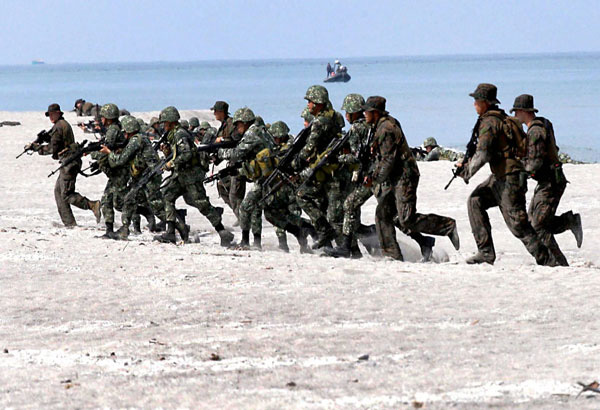Militarizing the South China Sea
"The Chinese goal is not to pick a fight. Just the ability to impose any kind of cost, to get any kind of vessel out there on site, forces the Chinese to make a decision about how much they really want to engage in a certain activity."
Gregory B. Poling, director, Asia Maritime Transparency Initiative, Center for Strategic International Studies, Washington
"I can’t speak for another nation and how they might react to this. But I can tell you that there’s nothing offensive or provocative with respect to any of the military capabilities that are permanently based in the Asia-Pacific region or are going to be rotationally based in the Pacific region."
"What it signals is our commitment to our alliance with the Philippines."
U.S. State Department spokesman John Kirby
 |
Which is where China is now building a military base, vexing Vietnam and the Philippines to no end. China is busying itself building outposts at Scarborough Shoal, disputed territory far distant from its mainland. All in the interests of 'planting its flag' of sovereignty where other, neighbouring nations feel that their own proximity should logically declare their more legitimate interests, which China haughtily disputes and then ignore, precisely how any schoolyard bully would comport itself.
Last month off Mischief Reef the American Navy cruiser, the U.S.S. Chancellorsville was alerted to a Chinese frigate speedily approaching it from Mischief Reef, with a helicopter lifting off from the frigate, flying straight toward the U.S. cruiser. "This is U.S. Navy warship on guard. Come up on Frequency 121.4 or 243" was the message speedily relayed by radio from the ship's bridge. Response there was none. As the helicopter pilot hovered and circled, flying back to the frigate, the U.S. cruiser's captain alerted the crew that trouble might be ahead.
And the captain called up a Chinese speaker in Ensign Niles Li, when English messages were ignored. "You're up. They can't pretend they don't speak Chinese." Ensign Li communicated: "Chinese Warship 575, this is U.S. Warship 62. Today is a sunny day for a sea voyage, over." An inspired bit of diplomacy, warship to warship. "U.S. Warship 62, this is Chinese Warship 575. Today's weather is great. It is a pleasure to meet you at sea", responded the Chinese frigate, nicely defusing the tense atmosphere.
Warships have this about them; they are geared for serious business. Bristling with missiles, torpedoes and heavy artillery, each is capable of heaving its military gear into action with confidence, although neither would aspire to do so if they really had no need to. And they had no need to. But the Chinese frigate was there for a purpose, to shadow the American cruiser, and it did just that for the rest of the day.
Which didn't dissuade the Chancellorsville from its purpose; appearing in waters that China is making every effort to claim for its own, unreservedly. And the purpose of the American warship in the area was to support its allies, and to convince China that it is prepared to do so. Roughly 700 American patrols have passed through the Spratlys and other disputed island chains, asserting in essence that the sea is freely open to all nations.
The United States has accused China of militarizing the South China Sea. China is now returning the compliment, grumbling that this is precisely what the U.S. is doing; a nation located far from the region but which has dispatched its navy to interfere in China's security and plans to establish its main-player dominance among its neighbours. China is responding to the new agreement between the U.S. and the Philippines whereby five military bases in the Philippines are slated for American facilities to be built to deploy more American troops, planes and ships.
Check and Checkmate.

At the 6th US-Philippines
Bilateral Strategic Dialogue in Washington, US Deputy
Assistant Secretary of Defense Amy Searight said the deal was reached
under the Enhanced Defense Cooperation Agreement (EDCA). STAR/File photo
Labels: China, Crisis Management, Philippines, Political Realities, South China Sea, United States

<< Home